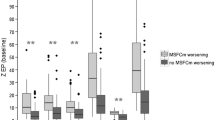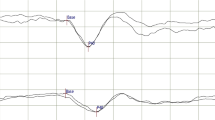Abstract
The triple stimulation technique (TST) was rarely used in multiple sclerosis (MS). This study aimed to compare TST and motor evoked potentials (MEP) for the quantification of motor dysfunction. Central motor conduction based on MEP (four limbs) and TST (upper limbs) was assessed in 28 MS patients with a median Expanded Disability Status Scale (EDSS) of 4. EDSS, timed 25-foot walk (T25FW), grasping strength and motor components of the MS functional composite were evaluated. Regression analysis was used to assess the relationship between MEP, TST and clinical findings. TST was negatively correlated with EDSS (r = − 0.74, p < 0.0001) and to a lesser extent with T25FW (r = − 0.47, p < 0.05), and grasping strength (r = − 0.43, p < 0.05). A multiple regression analysis underlined the better correlation between clinical data and TST (R2 = 0.56, p < 0.0005) than with MEP (0.03 < R2 < 0.22, p > 0.05). This study evidenced the value of TST as a quantification tool of motor dysfunction. TST appeared to reflect a global disability since it was correlated not only to hand function but also to walking capacity.


Similar content being viewed by others
References
Chen R, Cros D, Curra A, Di Lazzaro V, Lefaucheur JP, Magistris MR, Mills K, Rosler KM, Triggs WJ, Ugawa Y, Ziemann U (2008) The clinical diagnostic utility of transcranial magnetic stimulation: report of an IFCN committee. Clin Neurophysiol 119(3):504–532. https://doi.org/10.1016/j.clinph.2007.10.014
Fernandez V, Valls-Sole J, Relova JL, Raguer N, Miralles F, Dinca L, Taramundi S, Costa-Frossard L, Ferrandiz M, Ramio-Torrenta L, Villoslada P, Saiz A, Calles C, Antiguedad A, Alvarez-Cermeno JC, Prieto JM, Izquierdo G, Montalban X, Fernandez O (2013) Recommendations for the clinical use of motor evoked potentials in multiple sclerosis. Neurologia 28(7):408–416. https://doi.org/10.1016/j.nrl.2012.07.007
Hutchinson M (2013) Evoked potentials are of little use in the diagnosis or monitoring of MS: commentary. Mult Scler 19(14):1824–1825. https://doi.org/10.1177/1352458513506506
Zivadinov R, Leist TP (2005) Clinical-magnetic resonance imaging correlations in multiple sclerosis. J Neuroimaging 15(4 Suppl):10S–21S. https://doi.org/10.1177/1051228405283291
Ingram DA, Thompson AJ, Swash M (1988) Central motor conduction in multiple sclerosis: evaluation of abnormalities revealed by transcutaneous magnetic stimulation of the brain. J Neurol Neurosurg Psychiatry 51(4):487–494
Kandler RH, Jarratt JA, Davies-Jones GA, Gumpert EJ, Venables GS, Sagar HJ, Zeman A (1991) The role of magnetic stimulation as a quantifier of motor disability in patients with multiple sclerosis. J Neurol Sci 106(1):31–34
Facchetti D, Mai R, Micheli A, Marciano N, Capra R, Gasparotti R, Poloni M (1997) Motor evoked potentials and disability in secondary progressive multiple sclerosis. Can J Neurol Sci 24(4):332–337
Gagliardo A, Galli F, Grippo A, Amantini A, Martinelli C, Amato MP, Borsini W (2007) Motor evoked potentials in multiple sclerosis patients without walking limitation: amplitude vs. conduction time abnormalities. J Neurol 254(2):220–227. https://doi.org/10.1007/s00415-006-0334-5
Kale N, Agaoglu J, Onder G, Tanik O (2009) Correlation between disability and transcranial magnetic stimulation abnormalities in patients with multiple sclerosis. J Clin Neurosci 16(11):1439–1442. https://doi.org/10.1016/j.jocn.2009.03.009
Hess CW, Mills KR, Murray NM, Schriefer TN (1987) Magnetic brain stimulation: central motor conduction studies in multiple sclerosis. Ann Neurol 22(6):744–752. https://doi.org/10.1002/ana.410220611
Kalkers NF, Strijers RL, Jasperse MM, Neacsu V, Geurts JJ, Barkhof F, Polman CH, Stam CJ (2007) Motor evoked potential: a reliable and objective measure to document the functional consequences of multiple sclerosis? Relation to disability and MRI. Clin Neurophysiol 118(6):1332–1340. https://doi.org/10.1016/j.clinph.2007.02.018
Humm AM, Magistris MR, Truffert A, Hess CW, Rosler KM (2003) Central motor conduction differs between acute relapsing-remitting and chronic progressive multiple sclerosis. Clin Neurophysiol 114(11):2196–2203
Humm AM, Z’Graggen WJ, Buhler R, Magistris MR, Rosler KM (2006) Quantification of central motor conduction deficits in multiple sclerosis patients before and after treatment of acute exacerbation by methylprednisolone. J Neurol Neurosurg Psychiatry 77(3):345–350. https://doi.org/10.1136/jnnp.2005.065284
Comi G, Leocani L, Medaglini S, Locatelli T, Martinelli V, Santuccio G, Rossi P (1999) Evoked potentials in diagnosis and monitoring of multiple sclerosis. Electroencephalogr Clin Neurophysiol Suppl 49:13–18
Filippi M, Charil A, Rovaris M, Absinta M, Rocca MA (2014) Insights from magnetic resonance imaging. Handb Clin Neurol 122:115–149. https://doi.org/10.1016/B978-0-444-52001-2.00006-6
Rosler KM, Petrow E, Mathis J, Aranyi Z, Hess CW, Magistris MR (2002) Effect of discharge desynchronization on the size of motor evoked potentials: an analysis. Clin Neurophysiol 113(11):1680–1687
Magistris MR, Rosler KM, Truffert A, Myers JP (1998) Transcranial stimulation excites virtually all motor neurons supplying the target muscle. A demonstration and a method improving the study of motor evoked potentials. Brain 121(Pt 3):437–450
Banach M, Rakowicz M (2010) Electrophysiological diagnosis of amyotrophic lateral sclerosis. Przegl Lek 67(9):736–740
Xu Y, Zhang S, Fan D (2015) Upper motor neuron involvement in Kennedy disease evaluated by triple stimulation technique. Zhonghua Yi Xue Za Zhi 95(19):1522–1525
Sakuma K, Adachi Y, Fukuda H, Kai T, Nakashima K (2005) Triple stimulation technique in patients with spinocerebellar ataxia type 6. Clin Neurophysiol 116(11):2586–2591. https://doi.org/10.1016/j.clinph.2005.04.015
Eusebio A, Azulay JP, Witjas T, Rico A, Attarian S (2007) Assessment of cortico-spinal tract impairment in multiple system atrophy using transcranial magnetic stimulation. Clin Neurophysiol 118(4):815–823. https://doi.org/10.1016/j.clinph.2007.01.004
Attarian S, Franques J, Elisabeth J, Trebuchon A, Duclos Y, Wybrecht D, Verschueren A, Salort-Campana E, Pouget J (2015) Triple-stimulation technique improves the diagnosis of chronic inflammatory demyelinating polyradiculoneuropathy. Muscle Nerve 51(4):541–548. https://doi.org/10.1002/mus.24352
Taieb G, Grapperon AM, Duclos Y, Franques J, Labauge P, Renard D, Yuki N, Attarian S (2015) Proximal conduction block in the pharyngeal-cervical-brachial variant of Guillain–Barre syndrome. Muscle Nerve 52(6):1102–1106. https://doi.org/10.1002/mus.24729
Humm AM, Z’Graggen WJ, von Hornstein NE, Magistris MR, Rosler KM (2004) Assessment of central motor conduction to intrinsic hand muscles using the triple stimulation technique: normal values and repeatability. Clin Neurophysiol 115(11):2558–2566. https://doi.org/10.1016/j.clinph.2004.06.009
Hofstadt-van Oy U, Keune PM, Muenssinger J, Hagenburger D, Oschmann P (2015) Normative data and long-term test–retest reliability of the triple stimulation technique (TST) in multiple sclerosis. Clin Neurophysiol 126(2):356–364. https://doi.org/10.1016/j.clinph.2014.05.032
Rosler KM, Scheidegger O, Magistris MR (2009) Corticospinal output and loss of force during motor fatigue. Exp Brain Res 197(2):111–123. https://doi.org/10.1007/s00221-009-1897-z
Scheidegger O, Kamm CP, Humpert SJ, Rosler KM (2012) Corticospinal output during muscular fatigue differs in multiple sclerosis patients compared to healthy controls. Mult Scler 18(10):1500–1506. https://doi.org/10.1177/1352458512438722
Humm AM, Beer S, Kool J, Magistris MR, Kesselring J, Rosler KM (2004) Quantification of Uhthoff’s phenomenon in multiple sclerosis: a magnetic stimulation study. Clin Neurophysiol 115(11):2493–2501. https://doi.org/10.1016/j.clinph.2004.06.010
Firmin L, Muller S, Rosler KM (2012) The latency distribution of motor evoked potentials in patients with multiple sclerosis. Clin Neurophysiol 123(12):2414–2421. https://doi.org/10.1016/j.clinph.2012.05.008
Magistris MR, Rosler KM, Truffert A, Landis T, Hess CW (1999) A clinical study of motor evoked potentials using a triple stimulation technique. Brain 122(Pt 2):265–279
Polman CH, Reingold SC, Banwell B, Clanet M, Cohen JA, Filippi M, Fujihara K, Havrdova E, Hutchinson M, Kappos L, Lublin FD, Montalban X, O’Connor P, Sandberg-Wollheim M, Thompson AJ, Waubant E, Weinshenker B, Wolinsky JS (2011) Diagnostic criteria for multiple sclerosis: 2010 revisions to the McDonald criteria. Ann Neurol 69(2):292–302. https://doi.org/10.1002/ana.22366
Fischer JS, Jack AJ, Kniker JE, Rudick RA, Cutter G (2001) Administration and scoring manual for multiple sclerosis functional composite (MSFC) (revised). National Multiple Sclerosis Society, New York
Roberts HC, Denison HJ, Martin HJ, Patel HP, Syddall H, Cooper C, Sayer AA (2011) A review of the measurement of grip strength in clinical and epidemiological studies: towards a standardised approach. Age Ageing 40(4):423–429. https://doi.org/10.1093/ageing/afr051
Buhler R, Magistris MR, Truffert A, Hess CW, Rosler KM (2001) The triple stimulation technique to study central motor conduction to the lower limbs. Clin Neurophysiol 112(5):938–949
Magistris RM (2016) The triple stimulation technique: an advanced neurophysiological method to assess motor function in multiple sclerosis. J Mult Scler 3:3. https://doi.org/10.4172/2376-0389.1000188
Fuhr P, Borggrefe-Chappuis A, Schindler C, Kappos L (2001) Visual and motor evoked potentials in the course of multiple sclerosis. Brain 124(Pt 11):2162–2168
Schmierer K, Irlbacher K, Grosse P, Roricht S, Meyer BU (2002) Correlates of disability in multiple sclerosis detected by transcranial magnetic stimulation. Neurology 59(8):1218–1224
Leocani L, Rovaris M, Boneschi FM, Medaglini S, Rossi P, Martinelli V, Amadio S, Comi G (2006) Multimodal evoked potentials to assess the evolution of multiple sclerosis: a longitudinal study. J Neurol Neurosurg Psychiatry 77(9):1030–1035. https://doi.org/10.1136/jnnp.2005.086280
van der Kamp W, Maertens de Noordhout A, Thompson PD, Rothwell JC, Day BL, Marsden CD (1991) Correlation of phasic muscle strength and corticomotoneuron conduction time in multiple sclerosis. Ann Neurol 29(1):6–12. https://doi.org/10.1002/ana.410290104
Rocca MA, Horsfield MA, Sala S, Copetti M, Valsasina P, Mesaros S, Martinelli V, Caputo D, Stosic-Opincal T, Drulovic J, Comi G, Filippi M (2011) A multicenter assessment of cervical cord atrophy among MS clinical phenotypes. Neurology 76(24):2096–2102. https://doi.org/10.1212/WNL.0b013e31821f46b8
Boniface SJ, Mills KR, Schubert M (1991) Responses of single spinal motoneurons to magnetic brain stimulation in healthy subjects and patients with multiple sclerosis. Brain 114(Pt 1B):643–662
Giffroy X, Maes N, Albert A, Maquet P, Crielaard JM, Dive D (2016) Multimodal evoked potentials for functional quantification and prognosis in multiple sclerosis. BMC Neurol 16:83. https://doi.org/10.1186/s12883-016-0608-1
Giffroy X, Maes N, Albert A, Maquet P, Crielaard JM, Dive D, Humm AM (2016) Do evoked potentials contribute to the functional follow-up and clinical prognosis of multiple sclerosis? Acta Neurol Belg. https://doi.org/10.1007/s13760-016-0650-1
Acknowledgements
We would like to thank the patients who participated in this study.
Author information
Authors and Affiliations
Corresponding author
Ethics declarations
Conflict of interest
The authors of this study declare that they have no conflict of interest.
Ethical approval
All procedures performed in this study were in accordance with the ethical standards of the institutional and/or national research committee and with the 1964 Helsinki declaration and its later amendments or comparable ethical standards.
Informed consent
All patients gave their written informed consent.
Rights and permissions
About this article
Cite this article
Giffroy, X., Dive, D., Kaux, JF. et al. Is the triple stimulation technique a better quantification tool of motor dysfunction than motor evoked potentials in multiple sclerosis?. Acta Neurol Belg 119, 47–54 (2019). https://doi.org/10.1007/s13760-018-1001-1
Received:
Accepted:
Published:
Issue Date:
DOI: https://doi.org/10.1007/s13760-018-1001-1




